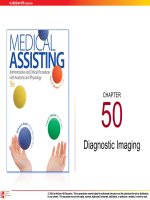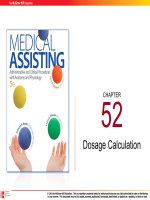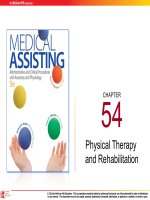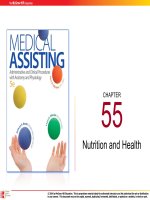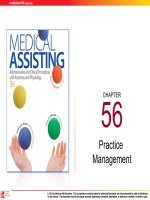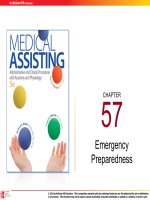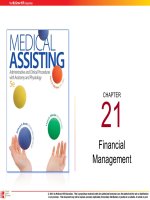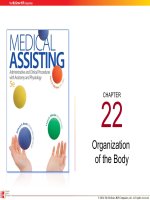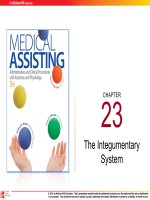Medical assisting Administrative and clinical procedures (5e) Chapter 53 Medication administration
Bạn đang xem bản rút gọn của tài liệu. Xem và tải ngay bản đầy đủ của tài liệu tại đây (1.05 MB, 59 trang )
CHAPTER
53
Medication
Administration
© 2014 by McGraw-Hill Education. This is proprietary material solely for authorized instructor use. Not authorized for sale or distribution
in any manner. This document may not be copied, scanned, duplicated, forwarded, distributed, or posted on a website, in whole or part.
53-2
Learning Outcomes
53.1 Describe rules and responsibilities regarding
drug administration and the initial
preparation for the drug administration.
53.2 List the rights of drug administration.
53.3 Recognize the correct equipment to use for
administering medications.
© 2014 by McGraw-Hill Education. This is proprietary material solely for authorized instructor use. Not authorized for sale or distribution
in any manner. This document may not be copied, scanned, duplicated, forwarded, distributed, or posted on a website, in whole or part.
53-3
Learning Outcomes
53.4 Carry out the procedures for administering
oral medications.
53.5 Carry out procedures for administering
parenteral medications.
53.6 Carry out procedures for administering
parenteral medications by other routes.
© 2014 by McGraw-Hill Education. This is proprietary material solely for authorized instructor use. Not authorized for sale or distribution
in any manner. This document may not be copied, scanned, duplicated, forwarded, distributed, or posted on a website, in whole or part.
53-4
Learning Outcomes
53.7 Relate special considerations required for
medication administration to pediatric,
geriatric, and pregnant patients.
53.8 Outline patient education information related
to medications.
53.9 Implement accurate and complete
documentation of medications.
© 2014 by McGraw-Hill Education. This is proprietary material solely for authorized instructor use. Not authorized for sale or distribution
in any manner. This document may not be copied, scanned, duplicated, forwarded, distributed, or posted on a website, in whole or part.
53-5
Introduction
• Drug administration
– Given correctly ~ restores health
– Given incorrectly ~ condition can worsen
• Medical assistant must
– Understand fundamentals
of drug administration
– Know your scope of
practice
© 2014 by McGraw-Hill Education. This is proprietary material solely for authorized instructor use. Not authorized for sale or distribution
in any manner. This document may not be copied, scanned, duplicated, forwarded, distributed, or posted on a website, in whole or part.
53-6
Preparing to Administer a Drug
• For common drugs know
– Uses
– Contraindications
– Interactions
– Adverse effects
• Be alert to any change in patient’s condition that could
affect drug therapy
© 2014 by McGraw-Hill Education. This is proprietary material solely for authorized instructor use. Not authorized for sale or distribution
in any manner. This document may not be copied, scanned, duplicated, forwarded, distributed, or posted on a website, in whole or part.
53-7
Preparing to Administer a Drug (cont.)
• Drug and drug allergies
– Keep an accurate medication list in the
patient record
– Ask about drug allergies
at every appointment
© 2014 by McGraw-Hill Education. This is proprietary material solely for authorized instructor use. Not authorized for sale or distribution
in any manner. This document may not be copied, scanned, duplicated, forwarded, distributed, or posted on a website, in whole or part.
53-8
Preparing to Administer a Drug (cont.)
• Administration site
– Check site of administration
– Be sure there are no contradictions to
using the site
© 2014 by McGraw-Hill Education. This is proprietary material solely for authorized instructor use. Not authorized for sale or distribution
in any manner. This document may not be copied, scanned, duplicated, forwarded, distributed, or posted on a website, in whole or part.
53-9
Preparing to Administer a Drug (cont.)
• Patient condition
– Assess overall condition
– Review drug list
– Be sure dose is appropriate
• Patient consent form
– Answer questions
– Have signed before administering injection
© 2014 by McGraw-Hill Education. This is proprietary material solely for authorized instructor use. Not authorized for sale or distribution
in any manner. This document may not be copied, scanned, duplicated, forwarded, distributed, or posted on a website, in whole or part.
53-10
General Rules for Drug Administration
• Give only drugs the doctor orders
• Wash your hands
– Prepare in a
well-lit area
– Focus on task
– Avoid distractions
© 2014 by McGraw-Hill Education. This is proprietary material solely for authorized instructor use. Not authorized for sale or distribution
in any manner. This document may not be copied, scanned, duplicated, forwarded, distributed, or posted on a website, in whole or part.
53-11
General Rules for Drug Administration
• Triple check medication
When taken from storage container and
matched to MAR
When prepared
Before administration
© 2014 by McGraw-Hill Education. This is proprietary material solely for authorized instructor use. Not authorized for sale or distribution
in any manner. This document may not be copied, scanned, duplicated, forwarded, distributed, or posted on a website, in whole or part.
53-12
General Rules for Drug
Administration (cont.)
• Calculate the dose carefully
• Do not leave a prepared drug unattended
• Do not administer a drug you did not prepare
• Verify patient identity
© 2014 by McGraw-Hill Education. This is proprietary material solely for authorized instructor use. Not authorized for sale or distribution
in any manner. This document may not be copied, scanned, duplicated, forwarded, distributed, or posted on a website, in whole or part.
53-13
General Rules for Drug
Administration (cont.)
• The physician must be in the office
• Have patient remain in office
• Instruct patient
© 2014 by McGraw-Hill Education. This is proprietary material solely for authorized instructor use. Not authorized for sale or distribution
in any manner. This document may not be copied, scanned, duplicated, forwarded, distributed, or posted on a website, in whole or part.
53-14
General Rules for Drug
Administration (cont.)
• If patient refuses the medication
– Discard properly
– Document
• Report medication errors
• Document after administering medication
© 2014 by McGraw-Hill Education. This is proprietary material solely for authorized instructor use. Not authorized for sale or distribution
in any manner. This document may not be copied, scanned, duplicated, forwarded, distributed, or posted on a website, in whole or part.
53-15
Apply Your Knowledge
What does “triple check” include?
ANSWER: The medication needs to be checked 3 times:
1st check – when you remove it from the storage area
and match it to the MAR
2nd check – when you prepare it
3rd check – before you close the storage container or
just before you administer the medication to
the patient
© 2014 by McGraw-Hill Education. This is proprietary material solely for authorized instructor use. Not authorized for sale or distribution
in any manner. This document may not be copied, scanned, duplicated, forwarded, distributed, or posted on a website, in whole or part.
53-16
Rights of Medication Administration
•
• Additional rights
Basic rights
– Right patient
– Right drug
– Right reason
– Right to know
– Right dose
– Right route
– Right to refuse
– Right technique
– Right time
– Right
documentation
© 2014 by McGraw-Hill Education. This is proprietary material solely for authorized instructor use. Not authorized for sale or distribution
in any manner. This document may not be copied, scanned, duplicated, forwarded, distributed, or posted on a website, in whole or part.
53-17
Rights of Medication Administration (cont.)
• Right Patient
– Ask patient for name and date of birth
– Check against record
• Right Drug
– Check ordered drug name against label
– Check expiration date
– Look up drug if unfamiliar
– Perform a triple check
© 2014 by McGraw-Hill Education. This is proprietary material solely for authorized instructor use. Not authorized for sale or distribution
in any manner. This document may not be copied, scanned, duplicated, forwarded, distributed, or posted on a website, in whole or part.
53-18
Rights of Medication Administration (cont.)
•
Right dose
– Read label
– Calculate accurately
•
Right route
– Matches route ordered
– Can be administered by route ordered
© 2014 by McGraw-Hill Education. This is proprietary material solely for authorized instructor use. Not authorized for sale or distribution
in any manner. This document may not be copied, scanned, duplicated, forwarded, distributed, or posted on a website, in whole or part.
53-19
Rights of Medication Administration (cont.)
•
Right time
•
Right documentation
– Immediately following administration
– Correct information
© 2014 by McGraw-Hill Education. This is proprietary material solely for authorized instructor use. Not authorized for sale or distribution
in any manner. This document may not be copied, scanned, duplicated, forwarded, distributed, or posted on a website, in whole or part.
53-20
Rights of Medication Administration (cont.)
•
Right reason
•
Right to know – patient education
•
Right to refuse
– Report to physician
– Document
•
Right technique – know the correct technique
© 2014 by McGraw-Hill Education. This is proprietary material solely for authorized instructor use. Not authorized for sale or distribution
in any manner. This document may not be copied, scanned, duplicated, forwarded, distributed, or posted on a website, in whole or part.
53-21
Apply Your Knowledge
How do you properly identify the patient before
administering a drug?
ANSWER: To ensure that you have the right patient,
you should check the name and date of birth on the
patient record and ask the patient to state his/her name
and date of birth.
© 2014 by McGraw-Hill Education. This is proprietary material solely for authorized instructor use. Not authorized for sale or distribution
in any manner. This document may not be copied, scanned, duplicated, forwarded, distributed, or posted on a website, in whole or part.
53-22
Drug Routes and Equipment
• You must be able to give drugs safely by any route
• In the medical office
– Buccal or sublingual medications
– Other routes based on scope of practice
– Demonstrate use of inhalers
– Topical drugs
© 2014 by McGraw-Hill Education. This is proprietary material solely for authorized instructor use. Not authorized for sale or distribution
in any manner. This document may not be copied, scanned, duplicated, forwarded, distributed, or posted on a website, in whole or part.
53-23
Medications by Mouth
• Oral administration
– Slower absorption
– Tablets, scored tablets, capsules,
lozenges, and liquids
– Contraindications
• Nausea
• Comatose
• Unable to swallow
– Patient education
© 2014 by McGraw-Hill Education. This is proprietary material solely for authorized instructor use. Not authorized for sale or distribution
in any manner. This document may not be copied, scanned, duplicated, forwarded, distributed, or posted on a website, in whole or part.
53-24
Medications by Mouth
• Buccal or sublingual administration
– Buccal – placed between the cheek and
gum
– Sublingual – placed under the tongue
– Faster absorption; bypasses GI tract
© 2014 by McGraw-Hill Education. This is proprietary material solely for authorized instructor use. Not authorized for sale or distribution
in any manner. This document may not be copied, scanned, duplicated, forwarded, distributed, or posted on a website, in whole or part.
53-25
Apply Your Knowledge
Gold star
Answer!
1. Why is it important to be able to administer
medications by a variety of methods?
ANSWER: You may be asked to administer drugs
by any of an number of different routes.
2. Why is absorption faster when drugs are
administered sublingually or buccally?
ANSWER: The drug is absorbed directly into the
bloodstream bypassing the GI tract.
© 2014 by McGraw-Hill Education. This is proprietary material solely for authorized instructor use. Not authorized for sale or distribution
in any manner. This document may not be copied, scanned, duplicated, forwarded, distributed, or posted on a website, in whole or part.
